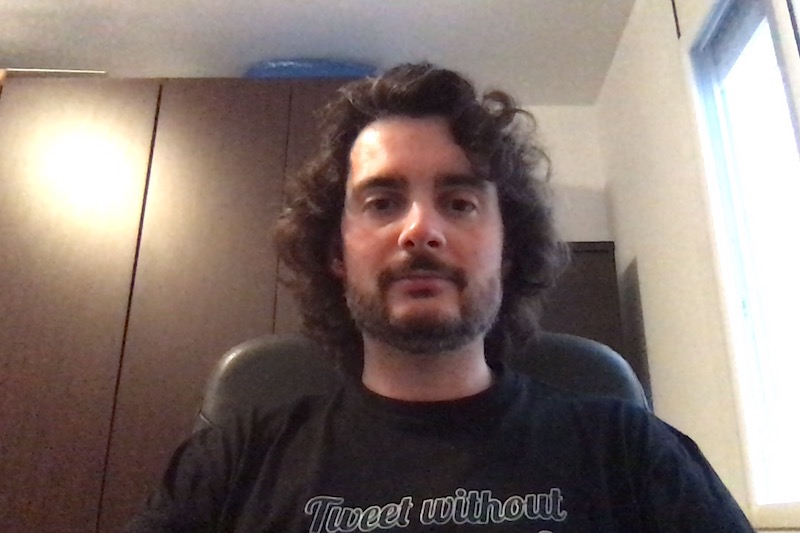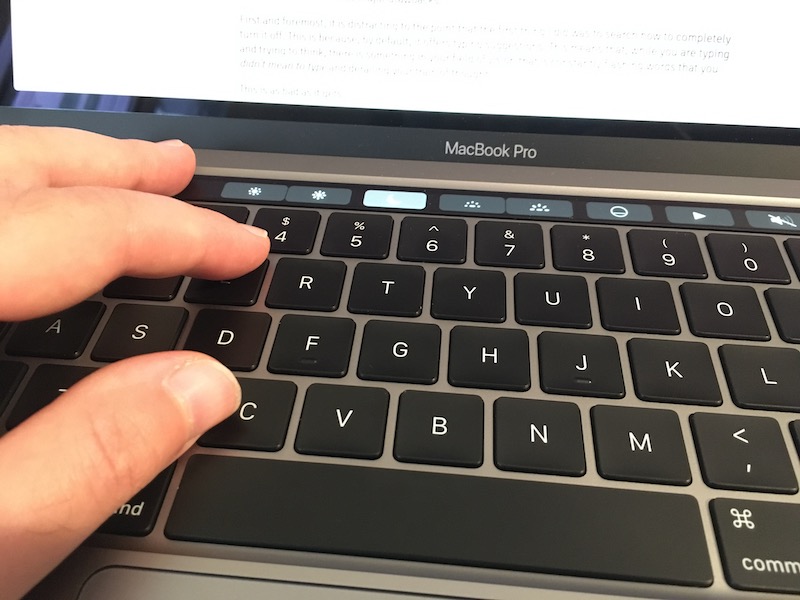Seven years later, I bought a new Macbook. For the first time, I don't love it
This article is part of a series:
The 2013 Macbook Air is the best computer I have ever owned. My wish has always been that Apple did nothing more than update the CPU and the screen, touching nothing else. I was afraid the day of upgrading my laptop would come.
But it came.
My Air was working flawlessly, if only unbearably slow when under load. Let me dig a bit deeper into this problem, because this is not just the result of using old hardware.
When video conferencing or under high stress like running multiple VMs the system would miss key presses or mouse clicks. I'm not saying that the system was laggy, which it was, and it is expected. Rather, that I would type the word "macbook" and the system would register "mok", for example. Or I would start a dragging event, the MouseUp never registered but the MouseMove continued working, so I ended up flailing an icon around the screen or moving a window to some unexpected place.
This is mostly macOS's fault. I own a contemporary x230 with similar specs running Linux and it doesn't suffer from this issue. Look, I was a computer user in the 90s and I perfectly understand that an old computer will be slow to the point of freezing, but losing random input events is a serious bug on a modern multitasking system.
Point #1: My old computer became unusable due to macOS, not hardware, issues.
As I mentioned, I had been holding on my purchase due to the terrible product lineup that Apple held from 2016 to 2019. Then Apple atoned, and things changed with the 2019 16". Since I prefer smaller footprints, I decided that I would buy the 13" they updated next.
So here I am, with my 2020 Macbook Pro, i5, 16 GB RAM, 1 TB SSD. But I can't bring myself to love it like I loved my 2013 Air.
Let me explain why. Maybe I can bring in a fresh perspective.
Most reviewers evaluate the 2020 lineup with the 2016-2019 versions in mind. But I'm just some random person, not a reviewer. I have not had the chance to even touch any Mac since 2015. I am not conditioned towards a positive judgement just because the previous generation was so much worse.
Of course the new ones are better. But the true test is to compare them to the best laptops ever made: 2013-2015 Airs and Pros.
Point #2: this computer is not a net win from a 2013 Air.
Let me explain the reasons why.
The webcam
You will see the webcam reviewed as an afterthought in most pieces. I will cover it first. I feel like Apple is mocking us by including the worst possible webcam on the most expensive laptop.
Traditionally, this has been a non-issue for most people. However, due to covid-19 and working from home, this topic has become more prominent.
In my case, even before the pandemic I used to do 2-3 video conferences every day. Nowadays I spend the day in front of my webcam.
What infuriates me is that the camera quality in the 2013 Air is noticeably better. Why couldn't they use at least the same part, if not a modern one?
See for yourself. It really feels like a ripoff. Apple laughing at us.

The 2020 macbook pro webcam looks horrible, and believe me, it is not only due to Yours Truly's face.

A reasonable quality picture from the 2013 Air

For reference, this is the front facing camera of the 2016 iPhone SE, same angle and lighting conditions.

As a second reference, a picture taken with the 640x480 VGA camera of my 2006
Nokia 5200. Which of the above looks the most like this?
I would have paid extra money to have a better webcam on my macbook.
The trackpad
The mechanism and tracking is excellent, but the trackpad itself is too large and the palm rejection algoritm is not good enough.
Point #3: The large trackpad single-handedly ruins using the experience of working on this laptop for me.
I am constantly moving the cursor accidentally.
This situation is very annoying, especially for a touch typist as my fingers are always on hjkl and my thumb on the spacebar. This makes
my thumb knuckle constantly brush the trackpad and activate it.
I really, really need to fix this, because I have found myself unconsciously raising my palms and placing them at a different angle. This may lead to RSI, which I have suffered from in the past.
This is a problem that Apple created on their own. Having an imperfect palm rejection algorithm is not an issue unless you irrationally enlarge the trackpad so much that it extends to the area where the palm of touch typists typically rests.
Is it worth it to antagonize touch typists in order to be able to move the cursor from this tiny corner?
I would accept this tradeoff if the trackpad was Pencil-compatible and we could use it as some sort of handwriting tablet. That would actually be great!
Another very annoying side effect of it being so large is that, when your laptop is in your lap, sometimes your clothes accidentally brush the trackpad. The software then registers spurious movements or prevents some gestures from happening because it thinks there is a finger there.
In summary, it's too big for no reason, which turns it into an annoyance for no benefit. This trackpad offers a bad user experience, not only that, it also ruins the keyboard—read below.
I would have paid extra money to have a smaller trackpad on my macbook.
The keyboard
The 2015 keyboard was very good, and this one is better. The keyswitch mechanism is fantastic, the layout is perfect, and this is probably the best keyboard on a laptop.
Personally, I did not mind the Escape key shenanigans because I remapped it to dual Ctrl/Escape years ago, which I recommend you do too.
Touch ID is nice, even though I'm proficient at typing my password, so it was not such a big deal for me. Face ID would have been much more convenient, I envy Windows Hello users.
Unfortunately, the large trackpad torpedoes the typing experience. Writing on this Macbook Pro is worse than on my 2013 Air.
I will keep searching for a tool which disables trackpad input within X miliseconds of a key press or disables some areas of the trackpad. I have not had any luck with neither Karabiner nor BetterTouchTool.
The Touchbar
After having read mostly negative feedback about it, I was determined to drill myself to like it, you know, just to be a bit contrarian.
"I will use tools to customize it so much that it will be awesome as a per-application custom function layer!"
Unfortunately, the critics are right. It's an anti-feature. I gave it an honest try, I swear. It is just bad, though it could have been better with a bit more effort.
I understand why it's there. Regular users probably find it useful and cute. It's ironically, a feature present in pro laptops meant for non-pro users: slow typists and people who don't know the regular keyboard shortcuts.
That being said, I would not mind it, probably would even like it, if it weren't for three major drawbacks:
First and foremost, it is distracting to the point that the first thing I did was to search how to completely turn it off.
This is because, by default, it offers typing suggestions. Yes, while you are typing and trying to concentrate, there is something in your field of vision constantly flashing words that you didn't mean to type and derailing your train of thought.
Easy to fix, but it makes me wonder what were Apple product managers thinking.
Secondly, it is placed in such a way that resting your fingers on top of the keyboard trigger accidental key presses.
I can and will retrain my hand placement habits. After all, this touchbar-keyboard-trackpad combo is forcing many people to learn to place their hands in unnatural positions to accommodate these poorly designed peripherals.
However, Apple could have mitigated this by implementing a pressure sensor to make it more difficult to generate involuntary key presses. It would be enough to distinguish a brush from a tap.
Finally, and this is also ironic because it's in contradiction with the previous point, due to lack of feedback, sometimes you're not sure whether you successfully pressed a touchbar key. And, in my experience, there is an unjustifiable large number of times where you have to press them twice, or press very deliberately to activate that key you want.
There are some redeeming features, though.
As stated above, I am determined to make it bearable, and even slightly useful for me, by heavily modifying it.
I suggest you go to System Preferences > Keyboard and use the "Expanded Control Strip".
Then, customize the touchbar buttons, remove keys you don't use, and add others. Consider paying for BetterTouchTool for even more customization options.
Then, on the same window, go to the Shortcuts tab, and select Function keys on the left. This allows you
to use function keys by default in some apps, which is useful for Terminal and other pro apps like Pycharm.
(Get the third irony? To make the touchbar, a pro feature, useful for pro apps, the best setup is to make it behave like normal function keys)
Finally, if you're registering accidental key presses, just leave an empty space in the touchbar to let your fingers rest safely until you re-train your hands to rest somewhere else. This is ridiculous, but hey, better than getting your brightness suddenly dimming to zero accidentaly.

Leave an empty space in the touchbar on the area where you are used to rest your fingers.
I would have paid extra money to not have a touchbar on my macbook.
The ports
Another much-debated feature where I resigned myself to just accept this new era of USB-C.
I did some research online and bought the "best" USB-C hub, along with new dongles. I don't mind dongles, because I was already using some with my Air. It's not like I swim in money, but there is no need to blow this out of proportion.
Well, I won't point any fingers to any review site, but that "best" hub is going back to Amazon as I write these lines. Some of my peripherals disconnect randomly, plus I get an "electric arc" noise when I disconnect the hub cable. I don't know how that is even possible.
The USB-C situation is terrible. Newly bought peripherals still come with USB-A cables. Regarding hubs, it took me a few years to find a reliable USB3 hub for my 2013 Air. I will keep trying, wish me luck.
About Magsafe, even though I really liked it, I don't miss it as much as I expected. I do miss the charging light, though. No reason not to have it integrated in the official cable, like the XPS does.
Some people say that charging via USB-C is actually better due to standardization of all devices, but I don't know what periperals these people use. My iPhone and Airpods charge via Lightning, my Apple Watch charges via a puck, and other minor peripherals like cameras and external batteries all charge via micro-USB. Now I have to carry the same amount of cables as before, I just swapped the Magsafe cable and charger for the USB-C cable and charger.
Another poorly thought decision is the headphone jack. It is on the wrong side. Most of the population is right-handed, so there usually is a notebook, mouse, or other stuff to the right of the laptop. The headphones cable then gets in the way. The port should have been on the left, and close to the user, not far away from them, to gain a few extra centimeters to the cable.
By the way, not including the extension cord is unacceptable. This cord is not only a convenience, but it increases safety, because it's the only way to have earth grounding for the laptop. Without it, rubbing your fingers on the surface of the computer generates this weird vibration due to current. I have always recommended Mac users that they use their chargers with the extension cable even if they don't need the extra length.
I would have paid extra money to purchase an Apple-guaranteed proper USB-C hub. Alternatively, I would have paid extra money for this machine to have a couple of USB-A ports so I can keep using my trusty old hub.
I would not have paid extra money to have the extension cord, because it should have come included with this 2,200€ laptop. I am at a loss for words. Enough of paying extra money for things that Apple broke on purpose.
Battery life
8-9 hours with all apps closed except Safari. Browsing lightly, with an occasional video, and brightness at the literal minimum. This brightness level is only realistic if it's night time. In a normally lit environment you need to set the brightness level at around 50%.
It's not that great. My Air, when it was new, easily got 12 hours of light browsing. Of course, it was not running Catalina, but come on.
When I push the laptop a bit more, with a few Docker containers, Pycharm running, Google Chrome with some Docs opened, and brightness near the maximum, I get around 4 hours. In comparison, that figure is reasonable.
Overall, it's not bad, but I expected more.
While we wait for a Low Power Mode on the mac, do yourself a favor and install Turbo Boost Switcher Pro.
The screen
Coming from having never used a Retina screen on a computer, this Macbook Pro impressed me.
Since I don't edit photos or videos professionally, I can only appreciate it for its very crisp text. The rest of features are lost on me, but this does not devalue my opinion of the screen.
The 500-nit brightness is not noticeable on a real test with my 2013 Air. For some reason, both screens seem equally bright when used in direct daylight.
This new Retina technology comes with a few drawbacks, though.
First, it's impossible to get a terminal screen without anti-aliasing. My favorite font, IBM VGA8, is unreadable when anti aliased, which is a real shame, because I've been using it since the 90s, and I prefer non-anti-aliased fonts on terminals.
Additionally, many pictures on websites appear blurry because they are not "retina-optimized". The same happens with some old applications which display crappy icons or improperly proportioned layouts. This is not Apple's fault, but it affects the user experience.
Finally, the bezels are not tiny like those in the XPS 13, but they are acceptable. I don't mind them.
To summarize, I really like this screen, but like everything else in this machine, it is not a net gain. You win some, you lose some.
Performance
This is the reason why I had to switch from my old laptop, and the 2020 MBP delivers.
It allows me to perform tasks that were very painful in my old computer. Everything is approximately three times faster than it was before, which really is a wow experience, like upgrading your computer in the 90s.
Not much to add. This is a modern computer and, as such, it is fast.
Build quality
Legendary, as usual.
To nitpick on a minor issue, I'd like Apple to make the palm rest area edges a bit less sharp. After typing for some time I get pressure marks on my wrists. They are not painful, but definitely discomforting.
Likewise, when typing on my lap, especially when wearing sports shorts in summer like I'm doing right now, the chassis leaves marks on my legs near the hinge area. Could have been reduced by blunting the edges too.
One Thousand Papercuts
In terms of software, Apple also needs to get its stuff together.
Catalina is meh. Not terrible, but with just too many annoyances.
- Mail keeps opening by itself while I'm doing video conferences and sharing my screen. I have to remind myself to close Mail before any video conference, because if I don't, other people will read my inbox. It's ridiculous that this bug has not been fixed yet. Do you remember when Apple mocked Microsoft because random alert windows would steal your focus while you were typing? This is 100x worse.
- My profile picture appears squished on the login screen, and there is no way to fix it. The proportions are correctly displayed on the iCloud settings window.
- Sometimes, after resuming from sleep, the laptop doesn't detect its own keyboard. I can assure you, the keyboard was there indeed, and note how the dock is still the default one. This happened to me minutes after setting up the computer for the first time, before I had any chance to install software or change any settings.
- I get constant alerts to re-enter my password for some internet account, but my password is correct. Apple's services need to differentiate a timeout from a rejected password, or maybe retry a couple times before prompting.
- Critical software I used doesn't run anymore and I have to look for alternatives. This includes Safari 13 breaking extensions that were important for me. Again, I was prepared for this, but it's worth mentioning.
Praise worthy
Here are a few things that Apple did really well and don't fit into any other category.
- Photos.app has "solved" the photos problem. It is that great. As a person who has 50k photos in their library, going back to pictures of their great grandparents: Thank you, Apple!
- Continuity features have been adding up, and the experience is now outstanding. The same goes for iCloud. If you have an iPhone and a Mac, things are magical.
- Fan and thermal configuration is very well crafted on this laptop. It runs totally silent, and when the fans kick off, the system cools down very quickly and goes back to silent again.
- The speakers are crisp and they have very nice bass. They don't sound like a tin can like most laptops, including the 2013 Air, do.
Conclusion
This computer is bittersweet.
I'm happy that I can finally perform tasks which were severely limited on my previous laptop. But this has nothing to do with the design of the product, it is just due to the fact that the internals are more modern.
Maybe loving your work tools is a privilege that only computer nerds have. Do taxi drivers love their cars? Do baristas love their coffee machines? Do gardeners love their leaf blowers? Do surgeons love their scalpels?
Yes, I have always loved my computer. Why wouldn't I? We developers spend at least eight hours a day touching and looking at our silicon partners. We earn our daily bread thanks to them. This is why we chose our computers carefully with these considerations in mind, why we are so scrupulous when evaluating them.
This is why it's so disappointing that this essential tool comes with so many tradeoffs.
Even though this review was exhaustive, don't get me wrong, most annoyances are minor except for the one deal-breaker: the typing experience. I have written this review with the laptop keyboard and it's been a continuous annoyance. Look, another irony. Apple suffered so much to fix their keyboard, yet it's still ruined by a comically large trackpad. The forest for the trees.
Point #4: For the first time since using Macs, I do not love this machine.
Going back to what "Pro" means
Apple engineers, do you know who is the target audience for these machines?
This laptop has been designed for casual users, not pro users. Regular users enjoy large trackpads and Touch Bars because they spend their day scrolling through Twitter and typing short sentences.
Do you know who doesn't, because it gets in the way of them typing their essays, source code, or inputting their Photoshop keyboard shortcuts? Pro users.
In 2016 I wrote:
However, in the last three to five years, everybody seemed to buy a Mac, even friends of mine who swore they would never do it. They finally caved in, not because of my advice, but because their non-nerd friends recommend MBPs. And that makes sense. In a 2011 market saturated by ultraportables, Windows 8, and laptops which break every couple years, Macs were a great investment. You can even resell them after five years for 50% of their price, essentially renting them for half price.
So what happened? Right now, not only Pros are using the Macbook Pro. They're not a professional tool anymore, they're a consumer product. Apple collects usage analytics for their machines and, I suppose, makes informed decisions, like removing less used ports or not increasing storage on iPhones for a long time.
What if Apple is being fed overwhelmingly non-Pro user data for their Pro machines and, as a consequence, their decisions don't serve Pro users anymore, but rather the general public?
The final irony: Apple uses "Pro" in their product marketing as a synonymous for "the more expensive tier", and they are believing their own lies. Their success with consumer products is fogging their understanding of what a real Pro needs.
We don't need a touchbar that we have to disable for Pro apps.
We don't need a large trackpad that gets in the way of typing.
We need more diverse ports to connect peripherals that don't work well with adapters.
We need a better webcam to increase productivity and enhance communication with our team.
We need that you include the effin extension cable so that there is no current on the chassis.
We need you to not splash our inbox contents in front of guests while sharing our screens.
We need a method to extend the battery as long as possible while we are on the road—hoping that comes back some day.
Point #5: Apple needs to continue course-correcting their design priorities for power users
Being optimistic for the future
I have made peace with the fact that, unlike my previous computer, this one will not last me for 7 years. This was a very important factor in my purchase decision. I know this mac is just bridging a gap between the best lineup in Apple's history (2015) and what will come in the future. It was bought out of necessity, not out of desire.
14" laptop? ARM CPUs? We will be awaiting new hardware eagerly, hoping that Apple keeps rolling back some anti-features like they did with the butterfly keyboard. Maybe the Touchbar and massive trackpad will be next. And surely the laggy and unresponsive OS will have been fixed by then.
What about the alternatives?
Before we conclude I want to anticipate a question that will be in some people's mind. Why didn't you buy another laptop?
Well, prior to my purchase I spent two months trying to use a Linux setup full-time. It was close, but not 100% successful. Critical software for my job had no real alternatives, or those were too inconvenient.
Regarding Windows, I had eyes on the XPS 13 and the X1 Carbon which are extremely similar to this macbook in most regards. I spent some time checking if Windows 10 had improved since the last time I used it and it turns out it hasn't. I just hate Windows so much it is irrational. Surely some people prefer it and feel the same way about the Mac. To each their own.
Point #6: Despite its flaws, macOS is the OS that best balances convenience with productive work. When combined with an iPhone it makes for an unbeatable user experience.
I decided that purchasing this new Mac was the least undesirable option, and I still stand by that decision. I will actively try to fix the broken trackpad, which will increase my customer satisfaction from a 6 —tolerate— to an 8 or 9 —like, even enjoy—.
But that will still be far away from the perfect, loving 10/10 experience I had with the 2013 Air.
Continue reading...